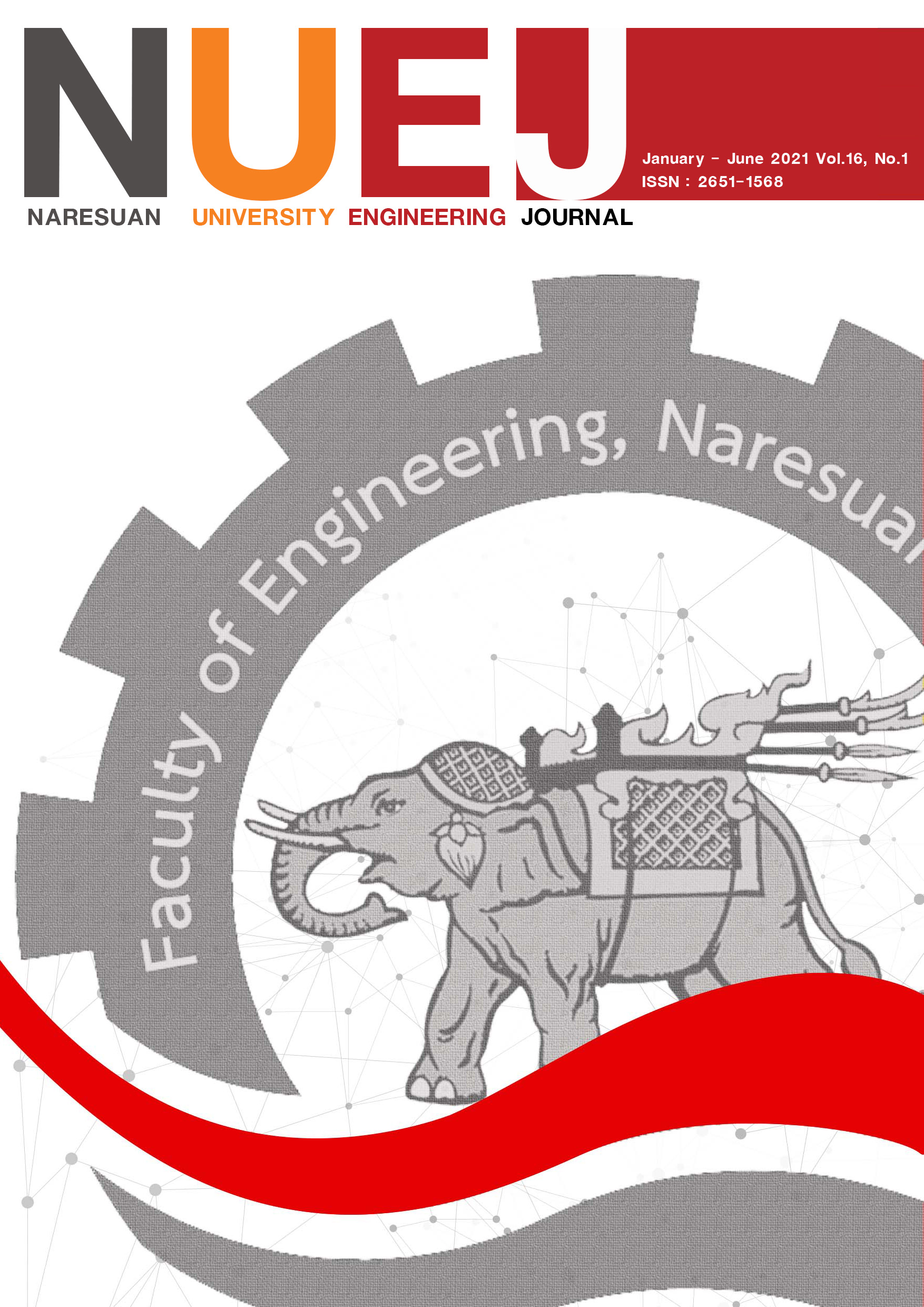Virtual Try-on Experience Mobile Application with Augmented Technology for Jewelry Business
Main Article Content
Abstract
This paper proposes the development of virtual try-on experience mobile application, by using augmented reality technology, for online jewelry customers virtually trying-on jewelry products to increase opportunity to sale products. The proposed system is developed using marker less technique. It applies the recognition technique to detect user’s hand. The three-dimensional (3D) model of the jewelry product with realistic rendering is modeled in which could be changed its details and size according to customer’s requirement. This method can reduce the production costs of the conventional process. The accuracy of the position of 3D ring model on finger is approximately 94.17% and 100% for the case of bangle. From testing with jewelry entrepreneurs and customers, the results reveal that the use of the proposed try-on experience mobile application in terms of ease-of-use and increasing confidence in making purchasing decisions are highest appreciated, while the realistic look issue is highly satisfied.
Article Details
References
Chatzopoulos, D., Bermejo, C., Huang, Z., & Hui P. (2017). Mobile Augmented Reality Survey: From Where We Are to Where We Go. IEEE Access, 5, 6917–6950.
Foxlin, E., Altshuler, Y., Naimark, L., & Harrington, M. (2004). Flight Tracker: A Novel Optical/Inertial Tracker for Cockpit Enhanced Vision. Third IEEE and ACM International Symposium on Mixed and Augmented Reality (pp. 212–221). Arlington, VA, USA. https://doi.org/10.1109/ISMAR.2004.32
Gans, E., Roberts, D., Bennett, M., Towles, H., Menozzi, A., Cook, J., & Sherrill, T. (2015). Augmented reality technology for day/night situational awareness for the dismounted Soldier. International Society for Optics and Photonics, 9470, 947004.
Klopfer, E., Perry, J., Squire, K., Jan, M.-F., & Steinkuehler, C. (2015). Mystery at the museum: a collaborative game for museum education. Proceedings of the 2005 Conference on Computer Support for Collaborative Learning. (pp. 316-320). Taipei, Taiwan. https://doi.org/10.3115/1149293.1149
Pretto, F., Manssour, I. H., Lopes, M. H. I., da Silva, E. R., & Pinho, M. S. (2009). Augmented reality environment for life support training. Proceedings of the 2009 ACM symposium on Applied Computing - SAC (pp. 836-841). Honolulu, Hawaii, USA. https://doi.org/10.1145/1529282.1529460
Khalifa, F. A., Semary, N. A., El-Sayed, H. M., & Hadhoud, M. M. (2016). Markerless Tracking for Augmented Reality Using Different Classifiers. Springer.
Nakamura, H., & Miyashita H. (2010). Control of augmented reality information volume by glabellar fader. https://dl.
acm.org/doi/10.1145/1785455.1785475
Dacre, K., & Urwin, R. (2018). Magic mirrors, 25 staircases and a giant 22ft screen - Burberry flagship store lands in Regent Street | London Evening Standard. https://www.standard.
co.uk/news/london/magic-mirrors-25-staircases-and-a-giant-22ft-screen-burberry-flagship-store-lands-in-regent-street-8134688.html
Livingston, M. A., Rosenblum, L. J., Julier, S. J., Brown, D., Baillot, Y., Swan Ii, J. E., Gabbard, J. L., & Hix, D. (2005). An Augmented Reality System for Military Operations in Urban Terrain. https://apps.dtic.mil/sti/citations/ADA499032
Bajura, M., Fuchs, H., Ohbuchi, R., Bajura, M., Fuchs, H., & Ohbuchi, R. (1992). Merging virtual objects with the real world. ACM SIGGRAPH Computer Graphics, 26(2), 203–210.
Billinghurst, M., & Duenser, A. (2012). Augmented Reality in the Classroom. Computer (Long Beach, Calif), 45(7), 56–63.
Billinghurst, M., Hakkarainen, M., & Woodward, C. (2008). Augmented assembly using a mobile phone. Proceedings of the 7th International Conference on Mobile and Ubiquitous Multimedia - MUM ’08 (pp. 167-168). Cambridge, UK. https://doi.org/10.1109/ISMAR.2008.46373
Hakkarainen, M., & Woodward, C. (2005). SymBall: camera driven table tennis for mobile phones. In ACM International Conference Proceeding Series, 265, 391-392.
Chen, P., Liu, X., Cheng, W., & Huang, R. (2017). A review of using Augmented Reality in Education from 2011 to 2016. Innovations in smart learning, 2017, 13–18.
Farrington, P., Nembhard, H., Sturrock, D. T., Evans, G. W., & Standridge, C. R. (1999). A Tutorial On Simulation in Health Care: Applications and Issues. Proceedings of the 1999 Winter Simulation Conference (pp. 49-55). Association for Computing Machinery. https://doi.org/ 10.1145/324138.324
Cavallaro, R., Cavallaro, R., Hybinette, M., & White, M. (2011). Augmenting live broadcast sports with 3D tracking information. IEEE MultiMedia, 18(4), 38.
Varadarajan, R., Srinivasan, R., Vadakkepatt, G. G., Yadav, M. S., Pavlou, P. A., Krishnamurthy, S., & Krause, T. (2010). Interactive technologies and retailing strategy: A review, conceptual framework and future research directions. Journal of Interactive Marketing, 24(2), 96-110.
Wen, R., Tay, W.-L., Nguyen, B. P., Chng, C.-B., & Chui, C.-K. (2014). Hand gesture guided robot-assisted surgery based on a direct augmented reality interface. Computer Methods and Programs in Biomedicine, 116(2). 68–80.
Chien, S., Choo, S., Schnabel, M. A., Nakapan,W. M., Kim, J., Roudavski, S. (Eds.). (2016). Living Systems and Micro-Utopias: Towards Continuous Designing. Proceedings of the 21st International Conference on Computer-Aided Architectural Design Research in Asia (CAADRIA 2016) (pp. 918). The University of Melbourne, Australia. http://papers.
cumincad.org/data/works/att/caadria2016_000.pdf
Henderson, S. J., & Feiner, S. K. (2011). Augmented reality in the psychomotor phase of a procedural task. Proceedings of the 2011 10th IEEE International Symposium on Mixed and Augmented Reality (pp. 191–200). Basel, Switzerland. https://doi.org/10.1109/ISMAR.2011.6092386
Yohan, S. J., Yohan, S. J., Julier, S., Baillot, Y., Lanzagorta, M., Brown, D., & Rosenblum, L. (2000). Bars: Battlefield augmented reality system. https://citeseerx.ist.psu.edu/
viewdoc/download?doi=10.1.1.1.5064&rep=rep1&type=pdf
Webel, S., Bockholt, U., Engelke, T., Gavish, N., Olbrich, M., & Preusche, C. (2013). An augmented reality training platform for assembly and maintenance skills. Robotics and Autonomous Systems, 61(4), 398–403.
Yusuke, S., Fukuda, T., Yabuki, N., Michikawa, T., & Motamedi, A. (2016). A Marker-less Augmented Reality System using Image Processing Techniques for Architecture and Urban Environment. Proceedings of the 21st International Conference on Computer-Aided Architectural Design Research in Asia (CAADRIA 2016) (pp. 713-722). Hong Kong. http://papers.cumincad.org/data/works/att/caadria2016_713.pdf
Piekarski, W., & Thomas, B. (2002). ARQuake: the outdoor augmented reality gaming system. Communications of the ACM, 45(1), 36-38.


